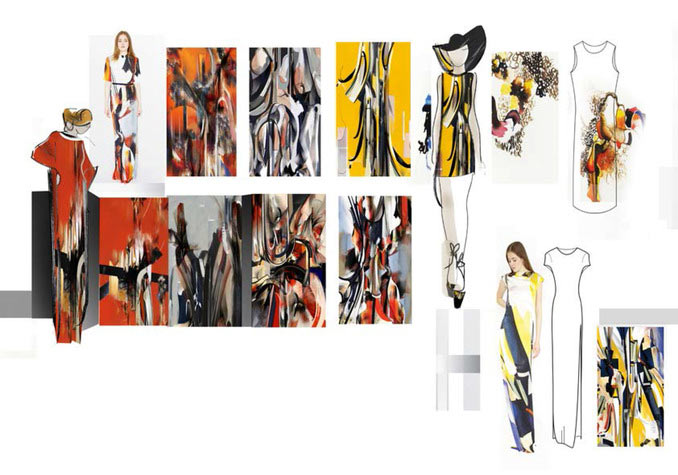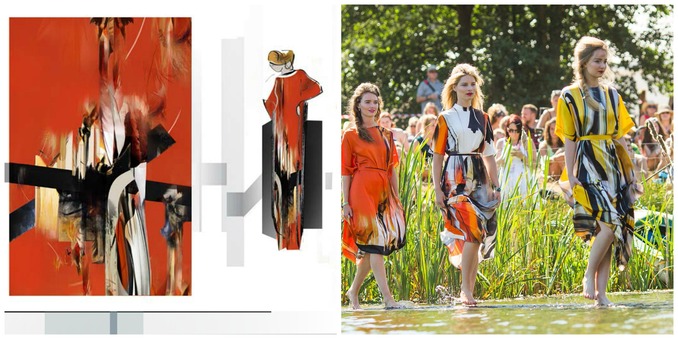Natasha Hulse
Natasha Hulse is the owner of Natasha LG Hulse Design and a graduate of Chelsea College of Art and Design. She specialises in print design, and her womenswear collections feature bold colours and flowing, yet well-structured garments.
As one of six children growing up in the New Forest, Natasha’s creativity was encouraged from a young age, and she designed ball gowns at secondary school for her and her friends.
She launched her first womenswear collection in 2014; her designs are sold in boutiques in London and New York, and she can count Diane von Furstenberg and Donna Karan New York as previous clients.
Natasha is enjoying her international success and is working hard to expand upon it, adopt new styles and further incorporate learned skills, such as footwear design, and ensure that her commitment to ethical fashion is present in her work.
In 2015, over tea in the Victoria and Albert Museum, Natasha talked further about her next collection: “I communicate a story through my clothes, it is emotion and mood based and my main focus and drive are the prints.”
“For my next collection I will look at the garment structure and then design the textile, it’s the concept of a more fashion driven collection rather than a textile driven collection.”
She also spoke to us about what drives her brand and her experiences of being a freelance print designer.
How did you start out in the fashion industry?
I completed a foundation course in Textile Fashion Design at Central Saint Martins, and then attended the Chelsea College of Art and Design where I studied Textile Design (Bachelor of Arts). Within the textiles degree, fashion was a huge influence, and that is where my interest in growing my own brand came from.
I went into fashion print design and in my second year applied for an Erasmus scheme in New York at the Fashion Institute of Technology (FIT); there I did pattern-making, draping, digital textiles and shoe-making. I started to understand the whole package of a fashion brand, doing everything from accessories to the actual garment.
In my third year, I started selling through an agency called Indesign, and I sold to Donna Karan and DVF.
How do you manage your work as a freelance designer?
It’s hard to find the time to find a balance between your own work and freelancing for others; every hour is your time to be working on something that you could get money for, because you’re not in a 9-5, salaried situation. Sometimes I do become a bit obsessive and then I realise that I need to let go and tell myself I’m going to have a relaxing day. I do like working constantly, though.
Another element has been finding out about the financial side and doing my own accounts, I was so frustrated with it at the beginning and now I feel so much more confident and it helps me to be aware of cash flow and how to price items.
When I was younger I used to ride horses and had a French Olympic trainer. He was incredibly tough and demanded you to be a perfectionist. I think that sort of discipline helps you become quite a strong, independent person and that’s the discipline you have to have when you’re freelancing.
How much do you change your designs to suit a client?
I’ve become quite versatile because at the beginning I would struggle to adapt to what they wanted from the brief. I’ve learned that it’s better to change because then you’re not selling so much of yourself; you’re selling something that is more about the client. It’s better to change and be more versatile, but it’s something you have to learn and it is hard.
Was it challenging to sell your designs to clients?
I found it incredibly hard because I’ve never really had to sell myself. But if you want to earn money you have to knock on peoples’ doors and you don’t really have much to lose if you think about it. You do have to approach everyone because no one is going to know about a small designer.
I had business cards made and would knock on every shop door that I wanted to sell in, I looked around Earl’s Court and East London – anywhere where I saw a boutique with an opportunity to sell a young designer. It’s not easy – people don’t open your emails and don’t get back to you so my biggest achievement was getting my garments into shops.
Tell us more about your print design process
I go and work with my pattern cutters, and I know all the processes and where the fabrics are from. I have a really nice relationship with the people that I produce my clothing with and that’s important.
I print in Bermondsey with acid dyes on silk and that holds a vibrant colour, and I make my clothes in Stratford – most of the factories are in north east London.

Is it expensive to put together one of your designs?
It’s quite hard to have a low price range in the UK, people are charging for their service – you can find a seamstress who will make your clothes for between £18-60 per hour. I go for the £18-25 per hour price range as that’s the lower end, my garments can range between £200-500.
Digital printing is expensive, but it’s something that I have based my whole brand on; it is the way that I can show my drawings and my aesthetic. Having your own brand and targeting the luxury market is an expensive business.
How do you find people to work with?
I use the internet a lot to research. The best tool to a business – I think – is research and finding things which work for you.
You can work with a seamstress who doesn’t speak very good English and you have to find how to work around that. Or sometimes you have to compromise and figure out how they [seamstresses] want to structure the garment if your way isn’t working for them. There’s a lot of give-and-take and trial and error, sometimes you do have to walk away and tell them if it isn’t working, and it is sad because you’ve built up a relationship with them. But if it isn’t working it isn’t working.
You state on your website that you never use fur or leather in your practice, why is that?
I have been a vegetarian since I was eight years old and I come from a farming background, so I have a love for animals.
I’ve got plenty of great products that I can use which are more ethical, and I don’t see the reason to wear fur or have angora or anything that is harmful to animals.
Sustainable Fashion is important: I’d rather know that I haven’t used a child to make my clothes, or that I haven’t put a little bunny rabbit under severe pain, or killed something just for a luxury good. That’s not what luxury means to me.
If you really believe in something, you have got to stay true to it because that’s the one thing you really own after selling your designs.
How do you compete with brands that do use leather and fur for their luxury goods?
Leather bags do probably last longer than a fabric bag, but there are so many other options: you can coat fabric, wax it or use a heavy canvas or other durable material.
There are brands like Matt & Nat who make vegan bags and they’re fantastic, there are so many products out there.
There is a niche in the market for better vegan shoes – there are not many great vegan shoe shops, that’s something that maybe I will look in to.

What is your plan for the next five years?
There are two things I would like to achieve: working for another designer and building up all the skills and production knowledge I would need and then applying it to my own brand to make a super brand.
I would also like to do a Masters Degree whilst working for my brand and continue to supply two collections a year to the stores.
Both plans are quite different but they still have the same outlook of continuing with my own brand – but with more knowledge and stability.
[insert page=’natasha-hulse3′ display=’content’]
What advice do you have for designers who are starting out?
Work hard and put everything into something you believe in.
You have to have a hard skin and be realistic – but be passionate, you’ve got to love what you do. Also, knowing your market is very important.
[convertkit form=790327]
To find out more about Natasha visit her profile on Utelier and get in touch directly, or visit her website.



